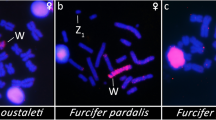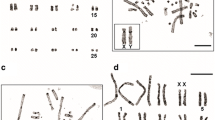Abstract
The bearded dragon, Pogona vitticeps (Agamidae: Reptilia) is an agamid lizard endemic to Australia. Like crocodilians and many turtles, temperature-dependent sex determination (TSD) is common in agamid lizards, although many species have genotypic sex determination (GSD). P. vitticeps is reported to have GSD, but no detectable sex chromosomes. Here we used molecular cytogenetic and differential banding techniques to reveal sex chromosomes in this species. Comparative genomic hybridization (CGH), GTG- and C-banding identified a highly heterochromatic microchromosome specific to females, demonstrating female heterogamety (ZZ/ZW) in this species. We isolated the P. vitticeps W chromosome by microdissection, re-amplified the DNA and used it to paint the W. No unpaired bivalents were detected in male synaptonemal complexes at meiotic pachytene, confirming male homogamety. We conclude that P. vitticeps has differentiated previously unidentifable W and Z micro-sex chromosomes, the first to be demonstrated in an agamid lizard. Our finding implies that heterochromatinization of the heterogametic chromosome occurred during sex chromosome differentiation in this species, as is the case in some lizards and many snakes, as well as in birds and mammals. Many GSD reptiles with cryptic sex chromosomes may also prove to have micro-sex chromosomes. Reptile microchromosomes, long dismissed as non-functional minutiae and often omitted from karyotypes, therefore deserve closer scrutiny with new and more sensitive techniques.
Similar content being viewed by others
References
Barzotti R, Pelliccia F, Rocchi A (2000) Sex chromosome differentiation revealed by genomic in situ hybridization. Chromosome Res 8: 459–464.
Bull JJ (1980) Sex determination in reptiles. Quart Rev Biol 55: 3–21.
Bull JJ (1983) Evolution of Sex Determining Mechanisms. Menlo Park, California: Benjamin/Cummings.
Charlesworth B (1991) The evolution of sex chromosomes. Science 251: 1030–1033.
Cogger HG (1996) Reptiles and Amphibians of Australia. Australia: Reed Books.
Donnellan (1985) The Evolution of Sex Chromosomes in Scincid Lizards. PhD thesis. Macquarie University, Sydney.
Ezaz MT, McAndrew BJ, Penman DJ (2004) Spontaneous diploidization of maternal chromosome set in Nile tilapia (Oreochromis niloticus) eggs. Aquaculture Res 35: 271–277.
Gorman GC (1973) The chromosomes of the Reptilia, a cytotaxonomic interpretation. In: Chiarelli AB, Capanna E, eds. Cytotaxonomy and Vertebrate Evolution. London, New York: Academic Press, pp. 349–424.
Harlow PS (2001) The ecology of sex-determining mechanisms in Australian agamid lizards. PhD Thesis. School of Biological Sciences. Macquarie University, Sydney.
Harvey SC, Campos-Ramos R, Kennedy DD et al. (2002) Karyotype evolution in tilapia: mitotic and meiotic chromosome analysis of Oreochromis karongae and O. niloticus × O. karongae hybrids. Genetica 15: 169–177.
Howell WM, Black DA (1980) Controlled silver-staining of nucleolus organizer regions with a protective colloidal developer – a 1-step method. Experientia 36: 1014–1015.
ISCN (1985) An International System for Human Cytogenetics Nomenclature: Birth Defects. Original article series. 1985, vol 21, No. 1. March of Dimes Birth Defects Foundation, NY.
Janzen FJ, Paukstis GL (1991) Environmental sex determination in reptiles: Ecology, evolution, and experimental design. Quart Rev Biol 66: 149–179.
Kallioniemi A, Kallioniemi OP, Sudar D et al. (1992) Comparative genomic hybridization for molecular cytogenetic analysis of solid tumors. Science 258: 818–821.
Miura I (1995) The late replicating banding patterns of chromosomes are highly conserved in the genera Rana, Hyla, and Bufo (Amphibia, Anura). Chromosoma 103: 567–574.
Olmo E (1986) A. Reptilia. In: John B, ed. Animal Cytogenetics 4 Chordata 3. Gebruder Berlin-Stuttgart: Bortraeger.
Olmo E, Signorino G (2005) Chromorep: a reptile chromosomes database. Internet references. Retrieved fromhttp://193.206.118.100/professori/chromorep.pdf, 2.10.05.
Olmo E, Cobror O, Morescalchi A, Odierna G (1984) Homomorphic sex chromosomes in lacertid lizard Takydromus sexlineatus. Heredity 53: 457–459.
Olmo E, Odierna G, Capriglione T (1987) Evolution of sex chromosomes in lacertid lizards. Chromosoma 96 (1): 33–38.
Pinkel D, Landegent J, Collins C et al. (1988) Fluorescence in situ hybridization with human chromosome specific libraries: detection of trisomy and translocation of chromosomes 4. Proc Natl Acad Sci USA 85: 9138–9142.
Ray-Chaudhury SP, Singh L, Sharma T (1971) Evolution of sex chromosomes and formation of W chromatin in snakes. Chromosoma 33: 239–251.
Sarre S, Georges A, Quinn A (2004) The ends of a continuum: Genetic and temperature-dependent sex determination in reptiles. Bioessays 26: 639–645.
Schweizer D (1976) Reverse fluorescent chromosome banding with chromomycin and DAPI. Chromosoma 58: 307–324.
Shine R, Elphick M, Donnellan S (2002). Co-occurrence of multiple, supposedly incompatible modes of sex determination in a lizard population. Ecol Lett 5: 486–489.
Singh L, Purdom IF, Jones KW (1976) Satellite DNA and evolution of sex chromosomes. Chromosoma 76: 137–157.
Sumner AT (1972) A simple technique for demonstrating centromeric heterochromatin. Exp Cell Res 75: 304–306.
Telenius H, Carter NP, Bebb CE, Nordenskjoeld M, Ponder BAJ, Tunnacliffe A (1992) Degenerate oligonucleotide-primed PCR: general amplification of target DNA by a single degenerate primer. Genomics 13: 718–725.
Traut W, Sahara K, Otto TD, Marec F (1999) Molecular differentiation of sex chromosomes probed by comparative genomic hybridization. Chromosoma 108: 173–180.
Traut W, Eickhoff U, Schorch J (2001) Identification and analysis of sex chromosomes by comparative genomic hybridization (CGH). Meth Cell Sci 23: 155–161.
Uetz P (2005) The EMBL reptile database. Internet references. Retrieved from:http://www.reptile-database.org, 2.10.05.
Verma RS, Babu A (1995) Human Chromosomes: Principles and Techniques, Second Edition. New York: McGraw-Hill, Inc.
Viets BE, Ewert MA, Talent LG, Nelson CE (1994) Sex determining mechanisms in squamate reptiles. J Exp Zool 270: 45–56.
Witten JG (1983) Some karyotypes of Australian agamids (Reptilia: Lacertilia). Austral J Zool 31: 533–540.
Yang F, Carter NP, Shi L, Ferguson-Smith MA (1995) A comparative-study of karyotypes of muntjacs by chromosome painting. Chromosoma 103 (9): 642–652.
Zeng X-M, Wang Y-Z Liu Z-J et al. (1997) Karyotypes on nine species in the genus Phrynocephalus, with discussion of karyotypic evolution of Chinese Phrynocephalus. Acta Zool Sinica 43: 399–410.
Author information
Authors and Affiliations
Corresponding author
Rights and permissions
About this article
Cite this article
Ezaz, T., Quinn, A.E., Miura, I. et al. The dragon lizard Pogona vitticeps has ZZ/ZW micro-sex chromosomes. Chromosome Res 13, 763–776 (2005). https://doi.org/10.1007/s10577-005-1010-9
Received:
Accepted:
Published:
Issue Date:
DOI: https://doi.org/10.1007/s10577-005-1010-9




